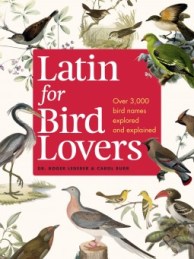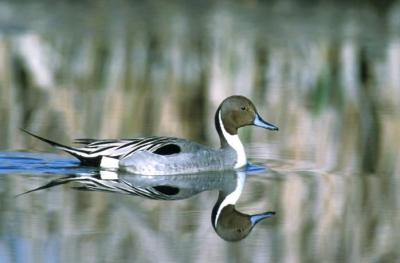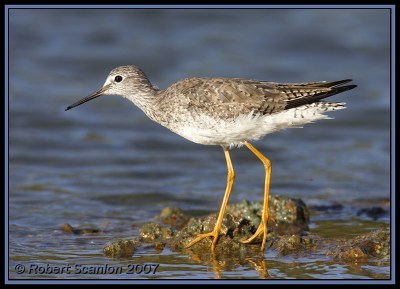
American Robin (Turdus migratorius) eating by Jim Fenton
HOW BIRDS ARE NAMED
From ~ Color Key to North American Birds, by Frank M. Chapman
Birds have two kinds of names. One is a common, vernacular, or popular name; the other is a technical or scientific name. The first is usually given to the living bird by the people of the country it inhabits. The second is applied to specimens of birds by ornithologists who classify them.
Common names in their origin and use know no law. Technical names are bestowed under the system of nomenclature established by Linnæus and their formation and application are governed by certain definite, generally accepted rules. The Linnæan system, as it is now employed by most American ornithologists, provides that a bird, in addition to being grouped in a certain Class, Order, Family, etc., shall have a generic and specific name which, together, shall not be applied to any other animal.
Our Robin, therefore, is classified and named as follows:
CLASS AVES, Birds.
ORDER PASSERES, Perching Birds.
Suborder Oscines, Singing Perching Birds.
Family –Turdidæ Thrushes.
Subfamily Turdinæ Thrushes.
Genus, Turdus Thrushes.
Species, migratorius American Robin.
The Robin’s distinctive scientific name, therefore, which it alone possesses, is Turdus migratorius. There are numerous other members of the genus Turdus, but not one of them is called migratorius and this combination of names, therefore, applied to only one bird.
The questions Why use all these Latin terms? Why not call the bird “Robin” and be done with it? are easily answered. Widely distributed birds frequently have different names in different parts of their range. The Northern Flicker (Colaptes auratus), for instance, has over one hundred common or vernacular names. Again, the same name is often applied to wholly different birds. Our Robin (Turdus migratorius) is not even a member of the same family as the European Robin (Erithacus rubecola.) If, therefore, we should write of birds or attempt to classify them only by their common names, we should be dealing with such unfixed quantities that the result would be inaccurate and misleading. But by using one name in a language known to educated people of all countries, a writer may indicate, without danger of being misunderstood, the particular animal to which he refers. Among people speaking the same tongue, where a definite list of vernacular names of animals has been established, they can of course be used instead of the scientific names.

European Robin (Erithacus rubecula) by Robert Scanlon
Such a list of North American birds has been prepared by the American Ornithologists’ Union. It furnishes a common as well as scientific name for each of our birds, and is the recognized standard of nomenclature among American ornithologists. The names and numbers of birds employed in this Color Key are those of the American Ornithologists’ Union’s ‘Check-List of North American Birds.’
It will be observed that in this ‘Check-List,’ and consequently in the following pages, many birds have three scientific names, a generic, specific, and subspecific. The Western Robin, for example, appears as Turdus migratorius propinquus. What is the significance of this third name?
In the days of Linnæus, and for many years after, it was supposed that a species was a distinct creation whose characters never varied. But in comparatively recent years, as specimens have been gathered from throughout the country inhabited by a species, comparison frequently shows that specimens from one part of its range differ from those taken in another part of its range. At intervening localities, however, intermediate specimens will be found connecting the extremes.
Generally, these geographical variations, as they are called, are the result of climatic conditions. For instance, in regions of heavy rainfall a bird’s colors are usually much darker than they are where the rainfall is light. Song Sparrows, for example, are palest in the desert region of Arizona, where the annual rainfall may not reach eight inches, and darkest on the coast of British Columbia and Alaska, where the annual rainfall may be over one hundred inches. In going from one region, however, to the other the gradual changes in climate are accompanied by gradual changes in the colors of the Song Sparrows, and the wide differences between Arizona and Alaska Song Sparrows are therefore bridged by a series of intermediates.
Variations of this kind are spoken of as geographic, racial, or subspecific and the birds exhibiting them are termed subspecies. In naming them a third name, or trinomial is employed, and the possession of such a name indicates at once that a bird is a geographic or racial representative of a species, with one or more representatives of which it intergrades.
Returning now to the Robin. Our eastern Robins always have the outer pair of tail-feathers tipped with white and, in adults, the back is blotched with black; while Robins from the Rocky Mountains and westward have little or no white on the outer tail-feathers, and the back is dark gray, without black blotches. These extremes are connected by intermediate specimens sharing the characters; of both eastern and western birds. We do not, therefore, treat the latter as a species, but as a subspecies, and consequently, apply to it a subspecific name or trinomial, Turdus migratorius propinquus, (propinquus, meaning nearly related.)
A further study of our eastern Robin shows that in the southern parts of its breeding range (the Carolinas and Georgia), it varies from the northern type in being smaller in size and much paler and duller in color; and to this second geographical variety is applied the name Turdus migratorius achrusterus, (achrusterus, meaning less highly colored).
After the recognition of western and southern races of the Robin under three names (trinomial) it would obviously be inconsistent to apply only two names (binomial) to our eastern bird, the former being no more subspecies of the latter than the latter is of the former. In other words, to continue to apply only generic and specific names to the Eastern Robin would imply that it was a full species, while the use of a trinomial for the Western or the Southern Robin shows them to be subspecies. As a matter of fact we know that there is but one species of true Robin in the United States, consequently in accordance with the logical and now generally accepted method, we apply to that species the name Turdus migratorius, and this is equally applicable to Robins from east, south or west. When, however, we learn that the Eastern Robin is not a species but a subspecies, we repeat the specific name by which it was made known and call it Turdus migratorius migratorius.
It may be asked, Why give names to these geographical races? Why not call Eastern, Western and Southern Robins by one name, Turdus migratorius, without regard to their climatic variations?
In reply, two excellent reasons may be given for the recognition of subspecies by name; first, because in some cases they differ from one another far more than do many species, when it would clearly be inadvisable to apply the same name to what are obviously different creatures. For example, it has lately been discovered by Mr. E. W. Nelson that the small, black-throated, brown-breasted, Quails or Bob-whites of southern Mexico, through a long series of intermediates inhabiting the intervening region, intergrade with the large, white-throated, black-and-white breasted, Bob-white of our northern states. It would be absurd to call such wholly unlike birds by the same name, nor could we give a full specific name to the Mexican Bob-white since at no place can we draw a line definitely separating it from the northern Bob-white. Furthermore, the use of only two names would conceal the remarkable fact of the intergradation of two such strikingly different birds; a fact of the first importance to students of the changing within species.
For much the same reason we should name those birds which show less pronounced variations, such as are exhibited by the Robin. Here we have a species in the making, and in tracing the relation between cause and effect, we learn something of the influences which create species. Thus, climate has been definitely proven so to alter a species, both in size and color that, as we have seen in the case of the Song Sparrows, marked climate changes are accompanied by correspondingly marked changes in the appearance of certain animals. In naming these animals we are, in effect, giving a ‘handle to the fact’ of their speciation by environment.
Bring out with you every living thing of all flesh that is with you: birds and cattle and every creeping thing that creeps on the earth, so that they may abound on the earth, and be fruitful and multiply on the earth.” So Noah went out, and his sons and his wife and his sons’ wives with him. Every animal, every creeping thing, every bird, and whatever creeps on the earth, according to their families, went out of the ark. (Genesis 8:17-19 NKJV)
Since it is evident that a bird may vary much or little, according to the governing conditions and its tendency to respond to them, no fixed rule can be laid down which shall decide just what degree of difference are deserving a name. It follows, therefore, that in some cases ornithologists do not agree upon a bird’s claim to subspecific rank.
In North America, however, questions of this kind are referred to a committee of seven experts of the American Ornithologists’ Union, and their decision establishes a nomenclature, which is accepted as the standard by other American ornithologists and which has been adopted in this volume.

Spotted Redshank (Tringa erythropus) by W Kwong – Listed as a Recent Sighting – NARBA
Foreign birds of wholly accidental occurrence, most of which have been found in North America but once or twice, are included in the systematic list of North American birds, but are not described or figured in the body of the book, where their presence would tend to convey an erroneous impression of their North American status. Furthermore, records of the presence of birds so rare as these can be properly based on only the capture of specimens.
In the preparation of the following pages both author and artist have had full access to the collections of the American Museum of Natural History, and they are also glad to acknowledge their indebtedness to William Brewster of Cambridge, Massachusetts, to Robert Ridgway, Curator of Birds in the United States National Museum, and to C. Hart Merriam, Chief of the Biologic Survey, for the loan of specimens for description and illustration.
(Some editing to correct a few names and wording. Bolding is mine.)
Today, the I.O.C, which I use here on the blog, is now the International Ornithologist Union. They are trying to standardize an English Name and a Scientific Names for all the birds of the world.
The article is a little technical, but helps explain the naming process. As I have said previously, Adam had it a little easier. There were less species and subspecies. Now there are over 10,400 species and at present, 20,989 subspecies. God commanded the birds to multiply and they have been obeying. Now we have the challenge of trying to put names on all of them. Every time they grow a different colored feather, I think they name it either a new species or a subspecies. :o)
See:
Birds of the World
Birds of the Bible
Leaving the Ark
Seven by Seven
*



















 s-k
s-k l
l
 r)
r)

















